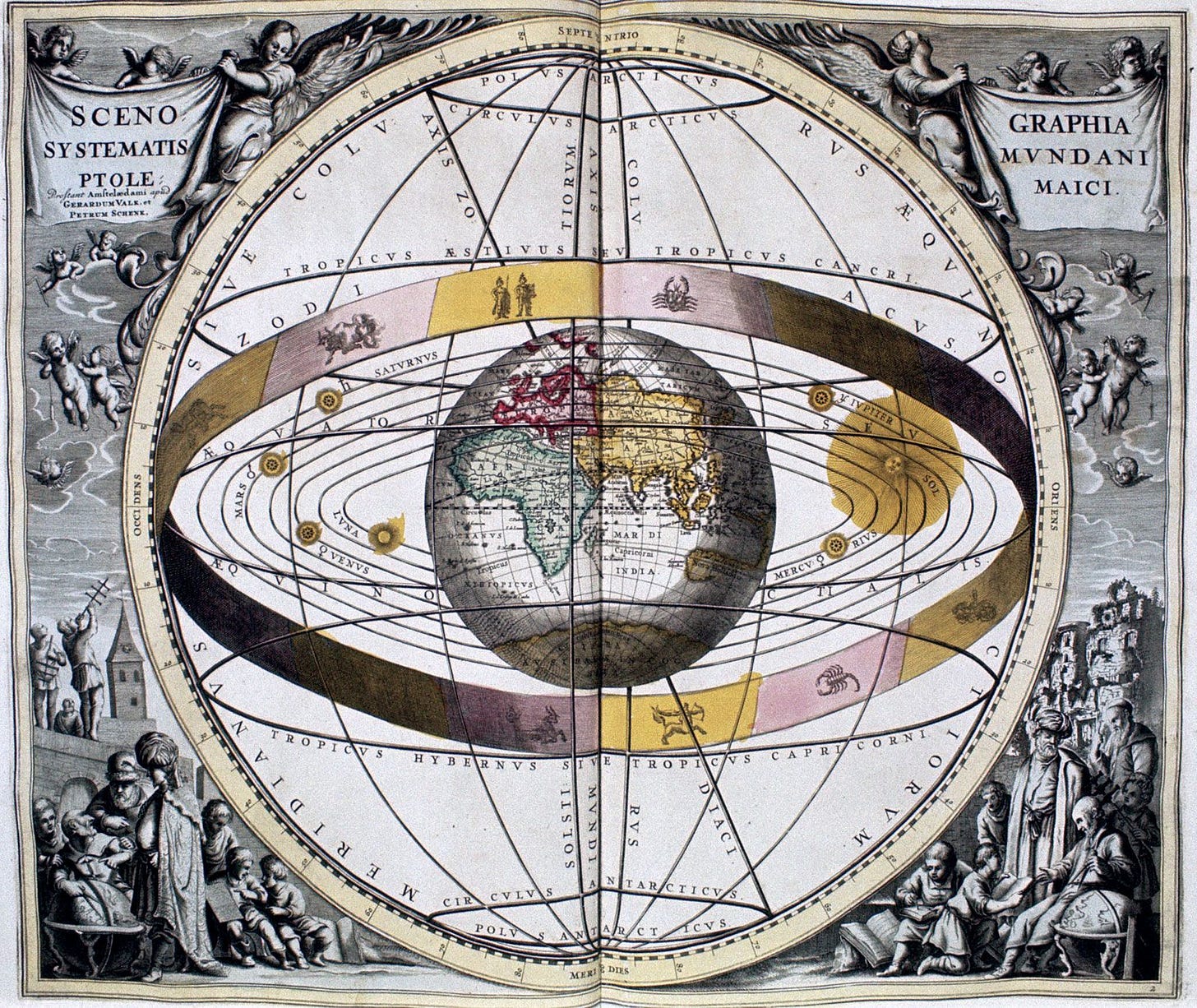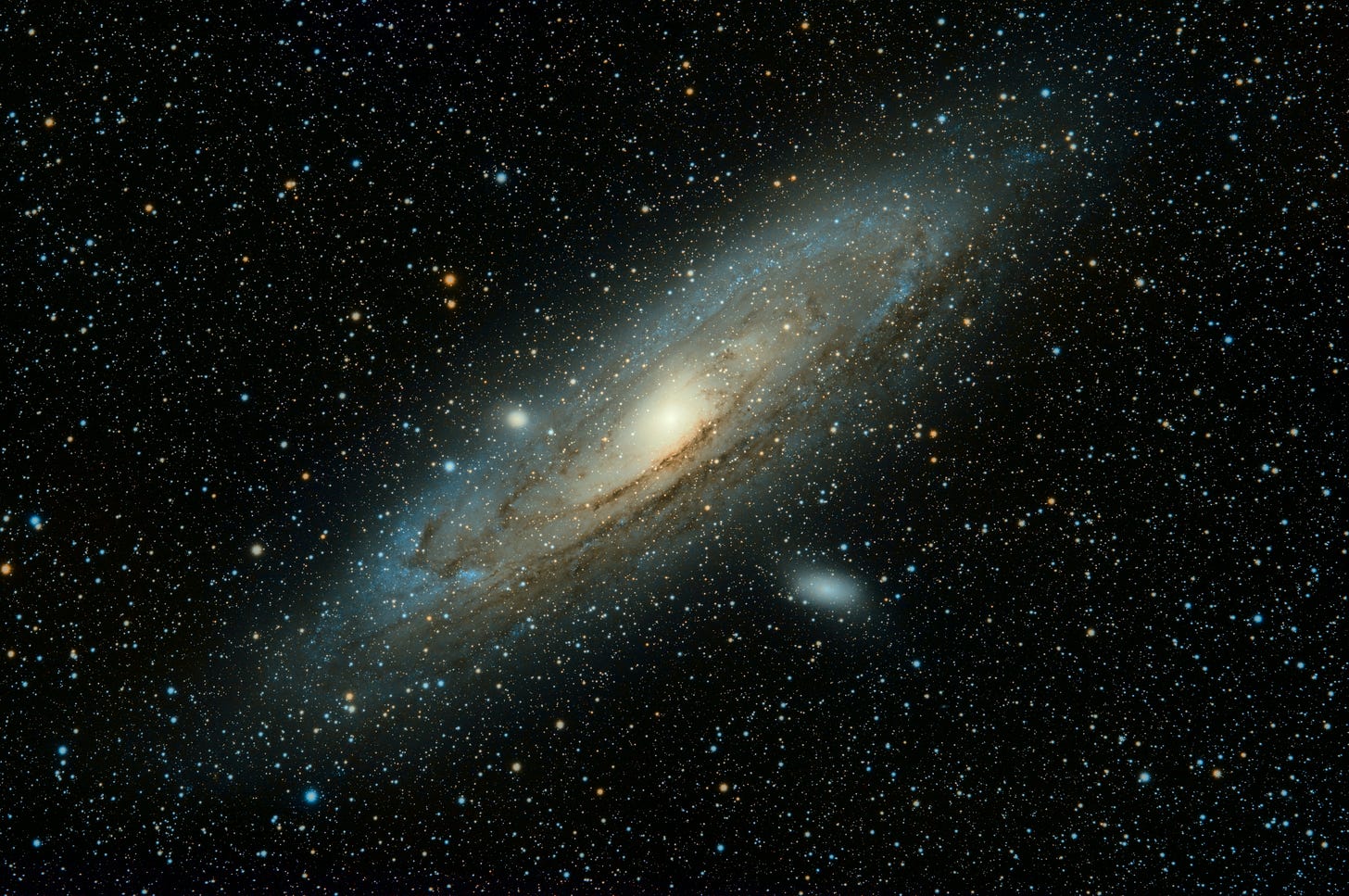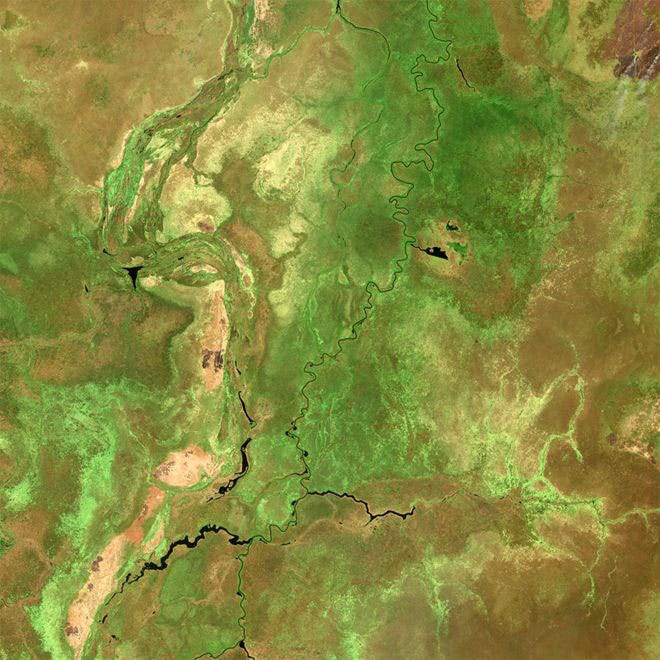The Quantitative Cosmology
The Historical Precedent for George Monbiot's Worldview and its Implications Today
“Too many green quants, then, and not enough green poets? I think so. Or rather, I think that the poets have been cowed into silence by the dominance and urgency of the quants’ narrative. How to reassert the importance of stories, then, is perhaps a key question now. Green poets might perhaps start by observing that worlds are not ‘saved’ by the same stories that are killing them. They might want to observe that saving worlds is an impossible business in the first place, and that attempting to do so is likely to lead to some very dark places. Or they might try and explore what it is about how we see ourselves which reduces us to this, time and time again, arguing about machines rather than wondering what those machines give us and what they take away.” — Paul Kingsnorth, The Quants and The Poets
“One of the Greatest Threats to Life on Earth is Poetry”
I recently watched a video which explained a rather interesting phenomenon that I had never heard of: that it’s impossible to measure coastlines and borders. This is called the “coastline paradox” and it was discovered by an English mathematician named Lewis Fry Richardson in 1950. He was researching the possible effect of border lengths on the probability of war when he noticed that there was a massive discrepancy between the reported length of the border between Portugal and Spain from each country. This discrepancy surprised him, because surely the perimeter of a finite area should be able to measured accurately, right?
Wrong, apparently. What happens is that when you start to measure a coastline or a border, from the point-of-view of a satellite, for example, it’s not possible to see all of the curves and variation in the land, so you have to zoom in. You may start measuring with a 100 kilometer ruler, and then as the picture becomes more clear and the complexity of the coastline becomes more obvious, you may have to shrink the ruler down to 50 kilometers. As is shown in the video, measuring Great Britain, if you halve the ruler, the length of the coastline increases. This will continue happening as you try to make the measuring stick more accurate by shrinking it. The “coastline paradox” is most pronounced in the mathematical certainty that you can shorten the length of your measuring stick down to the length of an atom, and the result will be a coastline that is infinity kilometers long. This mathematical problem (known as fractals) arises even before the consideration that the world is in constant flux (erosion and rising sea levels, as an example) and that everywhere, all the time, the Earth is transforming itself anew.
Straight lines and perfect angles do not fit easily into the natural world. Math is, therefore, a rather blunt instrument to wield in an attempt to understand the planet on which we live. We can try with all of our might to force the coastline to conform to our rulers, but at the end of the day, the tides move with the moon. The Earth resists these attempts at quantification and simplification at every turn.
Yet, today we have a society that is nearly completely fixated on datasets, statistics, and numbers. Anecdotes, observations, and felt experience are devalued as irrelevant outliers in nearly every single realm of societal and ecological analysis. We live in a time where nothing is even considered to be real until there is sufficient data to back it up. The level of abstraction from material reality belies a deep disconnect, not only from our individual intuitive sense of the world, but also our collective disconnect from our broader place in the web of life. We are bombarded with numbers: these pseudocertainties that do more to obscure than to inform.
Let’s take an example. As far as greenhouse gases go, methane has been given the distinction as being worse than carbon due to its comparative global warming potential, or GWP. Many people who are reasonably concerned about climate change hear this and understandably think, “Okay, clearly we need to eliminate this boogey-man methane.” They subsequently learn that cattle and other ruminant animals produce methane during enteric fermentation, which is the process that animals with rumens undergo as the grass that they eat is eaten by bacteria in one of their stomachs (fermenting, creating gas), which the animal will then eat to continue living. These “burps” have become an object of interest and talking point for many animal and climate activists. Many of these same activists would like to see the end of all livestock farming, and the “rewilding” of the landscape to allow for wild animals to once again proliferate.
I, too, would love to see more wild animals in the world. However, what is rarely, if ever, addressed is the fact that in a “rewilded” world, methane emissions from animals will not necessarily decrease, as the animals that would supposedly replace them (elk, moose, deer, wildebeest, giraffes, etc) are also ruminants and therefore also produce methane as a natural side affect of them eating.
So, we land at a conundrum. Methane has more global warming potential than carbon, yet the animals we all wish to see return to landscapes produce methane. There have already been calls in Norway to more severely manage moose populations due to methane emissions in the past. Now, the calls have shifted to culling them more intensely because they tend to eat deciduous saplings in clear-cuts (yes, from the lumber industry), which could eventually be potential storage for carbon. Yet, at the same time, moose foraging increases surface albedo (the reflection of heat from the sun) which increases cooling. Whether the animals are allowed to live or die depends largely on a math equation. Does this cooling provide enough of an offset in emissions from them eating as they have done for 2 million years to justify their continued existence? Only data scientists and researchers can know the answer to such a conundrum, apparently.
One of the best examples of this dilemma in accounting is the example of the Sudd Wetland in South Sudan, which is one of the largest freshwater ecosystems in the world. In 2019, YaleEnvironment360 reported that during the years 2010-2016 there was a massive increase in global methane emissions, and many climate researchers didn’t know where they came from. What atmospheric scientists discovered was that during that time, there were dam releases in the headwaters of the Nile which released tons of water into the Sudd Wetland, which led to an increase in plant growth and soil microbial activity. “Researchers estimate that wetlands in Africa’s tropics could account for up to a third of the spike in global methane emissions between 2010 and 2016, with most of this coming from the Sudd,” the article reads (emphasis mine).
This ecosystem is home to crocodiles, hippos, elephants, zebras, and shoe-billed storks rely on this wetland for their migrations. It also hosts one of the largest antelope migrations in the world.1 So, is methane a boogeyman, or not? Can we easily assign qualitative value to it? The issue is that, in all of these examples, we have people quantifying things that have objectively qualitative variables. The quantity of methane can’t be converted into a qualitative analysis because its role in the environment is complex. Is it even possible to invent a value that compares the benefit of this wetland with the amount of methane it is emitting? Is there a way to determine with accuracy the "offset" potential of such so-called "ecosystem services"?
Is that even the right question?
Still, scientists are concerned enough about the methane from wetlands to consider draining them in the name of climate change.2 Like the attempt to measure coastlines or borders, or trying to understand the ecological crisis through measurable values alone, it’s important to consider all that is left out of the accounting. As I’ve said before, it’s dangerous to implement such reductionistic thinking onto problems as complex as climate change, mass extinction, and ecocide. It’s insufficient to fixate on things that are easily measured while ignoring things that resist reductionistic measurement. Biodiversity, as an example, can be measured by the counting of individuals in a given plot of land, but what is much more challenging to measure, and is arguably more important, is the relationships between all of the individuals. How does the ecosystem function as an interconnected community of those individuals? That will be challenging to put into words, let alone into numeric value.
In the world today, we might take for granted the value of mathematics and science for it’s undeniable advancements to technology and therefore our society. People shout from the mountaintops to “believe” in science, putting signs in their yards and bumper stickers on their cars to declare so.
Yet, I think we’re in a strangely regressive time if science is something to “believe” in, which is only evidenced by the fact that it’s controversial for me to even say so. Science is a measurement tool— it’s a framework of inquiry, not the inquiry itself.
On a daily basis I see us further devaluing the “evidence of our eyes and ears” in order to ratify our belief in science. We use numbers to justify our points of view from obscure datasets that are constantly shifting as we begin to understand more what we are measuring and not measuring. We’re all speaking in this newspeak of percentages and abstractions in an attempt to validate our worldview and obfuscate our complicity in the mess we’re all in. No one can seem to agree on the numbers, yet without wielding them, our worldview is considered backwards and ignorant. Any attempts to understand the world outside of this paradigm is regressive, romantic, and overly poetic.
The extremis of this disdain for extra-empirical understanding can be summed up in George Monbiot’s unflinching statement near the end of his book, Regenesis:
“One of the greatest threats to life on Earth is poetry.”3
It’s quite a statement. If you haven’t heard of George Monbiot, who is a regular writer for the Guardian with more than half a million followers on Twitter, you might soon. A prominent vegan environmental activist, Monbiot has a relatively outsized influence on the direction of our food system and his point of view is explicitly anti-livestock and pro-technology.
Monbiot has recently linked up with an organization called RePlanet to promote a new movement, Reboot Food, which aims to transform and “revolutionize” the food system with technology. Precision fermentation, creating proteins from microbes, they claim, is the solution to feeding, and saving, the world.
It’s a compelling video, and it rightly shows some of the horrors of conventional animal agriculture. But, when I first saw this video, I was struck by the insinuation that the reason people don’t want to eat this food is because it’s unusual. What I saw was not a strange glob of bacteria that made me uneasy to think of eating— no, I saw the expanse of the industrial food system and the corporations at its helm luxuriating in the opportunity to diversify, yet again. I saw more chronic disease from processed foods. I saw more factories, more machines. I saw a glimpse into a future that concerns me deeply.
I knew I needed to read his book, Regenesis, to really see what his point of view was and where it came from. What astonished me most was how rigorous his analysis of the food system was, and how much I agreed with his assessments. How, I wondered, was it possible for him to be so clear on how disastrous our global food system is… to then end up here, with precision fermented factory-food as the solution?
It was so confounding to me that we could come to such wildly different conclusions from such an agreement about the global food system that I couldn’t just ignore it. As I read, I could sense there was something deeper that would cause such a cavernous expanse between our conclusions. And then I read this, near to the end of the book, which said it all:
“It’s time we became obsessed by numbers. We need to compare yields, compare land uses, compare the diversity and abundance of wildlife, compare emissions, erosion, pollution, costs, inputs, nutrition, across every aspect of food production.”4
It’s time we became obsessed by numbers.
Doing this project over the last 3 years, I’ve come to realize the danger (a word I’m not using lightly) of relying on numbers, data, and statistics to form our understanding of the living world. It’s no secret that I believe our collective hyper-fixation on carbon as the-root-of-all-evil is a dangerous obfuscation that distracts us from dealing with the ecological crisis, and I believe we fixate on it because we can measure it. Ecosystem health, biodiversity, shifting baseline syndrome, trophic cascade, co-evolution, sacredness, connection, relationships— these are much harder to measure, and are often left out of analysis completely.
Whether he’s aware of the epistemological genesis of the language and worldview he is deploying, his ultimate understanding of the food system, climate change (as an umbrella term), and what to do about it is emblematic of the scientism, reductionism, atomism, and the impulse to view the world in mathematical terms. This epistemology arose from a story that began long ago, and is one that people need to know.
This worldview, which was forged in flames of the Renaissance and lubricated by the first percolations of globalized corporatism, has now become fuel for an impenetrable technological machine. Though it was set into motion by the Scientific Revolution, and has expanded its territory through colonialism and industrialism ever since, the fuel is the worldview, and the worldview started somewhere: it started with the idea that all of nature can and should be ordered, apprehended, measured, and numbered by Man.
If we want to persist into the future without destroying the web of life, we know we need to change. The endpoint of this worldview is what exists around us all today, which any person can see is a society covered in necrotizing wounds, destroying its own basis for life in a seemingly unconscious death-march. Yet, as Charles Eisenstein explains in Climate: A New Story:
“The totalizing quest to capture the world in number never succeeds. Something always escapes the metrics and the models: the unmeasurable, the qualitative, and what seems irrelevant. Usually, the judgement as to what is relevant encodes the intellectual biases of those doing the measuring, and often the economic and political biases too. You might say that what is left out is our shadow. Like many things we ignore or suppress, it roars back in the form of perverse, unforeseeable consequences. Thus, although it is the epitome of rationality to make decisions by the numbers, the results often appear to be insane.”5
As you’ll see in this piece, I agree with Monbiot about a great deal and I do not seek to demonize him. I seek to interrogate his worldview, because he is far from alone in believing this is the direction humanity should go, and it’s important for there to be debate and dialogue about this. Our agreements can only go so far as the assumptions and epistemologies that we derive our conclusions from. In this regard, we may be irreconcilably opposed. It’s important to me to illustrate why this epistemology exists and what it looks like now.
I believe that we all have a responsibility to try to understand our current predicament not just by describing what is happening now, but by going far enough back to get a clear idea of where we came from. Bear with me: this history is long, and its expression today is immense. This is going to be a long one.
So, where did this “quest to capture the world” begin?

A Mathematic Worldview
Since the times of Plato, Pythagoras, and Aristotle, philosophers had speculated that there was an inherent mathematical quality to the world. Looking up toward the heavens, the ancients watched the sun, moon, and stars and their seeming rotations around the earth and made the determination that we lived in a geocentric universe, which became central to the Aristotelian cosmology. This cosmology specified that the ellipses of the planets were circular, and the Earth was stationary at the center of the universe. This geocentric model had long been concretized by the time Ptolemy, a Roman mathematician and astronomer, arose to acclaim. For hundreds of years, Hellenistic astronomers took for granted the Earth-centered universe, but it wasn’t until Ptolemy established a working mathematical paradigm, called the Almagest, that astronomers had a collection of mathematical tools to predict the position of the planets, as well as explain the Aristotelian cosmology. This treatise would be the most authoritative text on astronomy across Europe, North Africa, and the Middle East for over a thousand years.
Very quickly, however, mathematical discrepancies began to arise. The demand that the planets and the stars orbit in perfect circles around the Earth created a mess of irregularities, which then had to be further explained away by certain mathematical caveats, such as epicycles, eccentrics, equants, and all manner of equations to explain these anomalies.6 The differing speed of the planets, and planetary retrogrades all had corresponding Ptolemaic explanations.
It wouldn’t be until before the Protestant Reformation that Copernicus would be pouring over these Ptolemaic equations, riddled with inaccuracies that had only compounded over the past thousand years, that he started to wonder if there was a fundamental error at the center of the way astronomers had been thinking about the universe. Copernicus knew the danger of such a revelation, but primed with a “Pythagorean conviction that nature was ultimately comprehensible in simple and harmonious mathematical terms,” he took the risk to innovate the system with the sun at the center of the universe, and “mathematically worked out the implications.”7
Initially, the Catholic Church did not balk at such an innovation, but with the antagonism of the Protestant Reformation, a paranoia and revived orthodoxy compelled the Church to eventually reject Copernicus’s findings. It became the belief that the idea of Earth moving around the sun posed a fundamental threat to the Christian cosmology. If the Earth was not the stationary center of the universe and was nothing more than a “wandering star”— Creation and the plan of salvation were thrown into doubt. “The absolute uniqueness and significance of Christ’s intervention into human history seemed to require a corresponding uniqueness and significance for Earth,” Richard Tarnas explains in The Passion of the Western Mind. Still, Copernicus’s book on the matter was eventually published, albeit as a forbidden and highly technical treatise that few people could even read.
In spite of its obscurity, when Kepler and Galileo got their hands on it, it spoke to them as a text that not only further explained the mathematical qualities of the cosmos, but also saw that the Copernican theory confirmed God’s glory rather than denying it. When Kepler adjusted the heliocentric theory to contain elliptical orbits rather than circular orbits, finally solving the problem of the heavens, he fulfilled the mission of the ancients to find genuine evidence for a mathematically ordered universe.8
“Philosophy [nature] is written in that great book which ever is before our eyes — I mean the universe—but we cannot understand it if we do not first learn the language and grasp the symbols in which it is written. The book is written in mathematical language, and the symbols are triangles, circles and other geometrical figures, without whose help it is impossible to comprehend a single word of it; without which one wanders in vain through a dark labyrinth.” — Galileo Galilei
According to Tarnas, Galileo “argued that to make accurate judgements concerning nature, scientists should consider only precisely measurable ‘objective’ qualities (size, shape, number, weight, motion), while merely perceptible qualities (color, sound, taste, touch, smell) should be ignored as subjective and ephemeral. Only by means of an exclusively quantitative analysis could science attain certain knowledge of the world.”9
While these astronomers and mathematicians were focused on apprehending the universe through the use of a new way of knowing, the newly created class of European merchants were apprehending the Earth, creating the first global corporate empires. “A new celestial world was opening up to the Western mind, just as a new terrestrial world was being opened by the global explorers,” Tarnas writes. European expansion and colonial power further reinforced the worldview that was growing at this time. The invention of Galileo’s telescope in 1609, represented a paradigm shift. The development of the telescope reinforced the idea that, in order to understand nature more clearly, we must distance ourselves from it through the use of instruments. The idea of a mechanical intermediary being necessary was only possible in light of the technological advancements that were co-occurring in the expansion of the globalized, corporate system.10 In The Reenchantment of the World, Morris Berman writes of this shift: “Separate yourself from nature so you can, as Descartes would later urge, break it into the simplest parts and extract the essence— matter, motion, measurement.” Though Galileo was famously subjected to house arrest until his death for his inventions and ideas, this concept, that measurement was the most important tool to understanding nature, would ultimately lead to the end of the Medieval way of knowing.

From Math to Mechanics: the Paradigm of Control
A new scientific paradigm had begun. Galileo had proved that instruments could be used to further understand the universe, and Kepler had proved that there was a mathematical order to everything.
This faith in the mathematic ordering of the world led René Descartes to wield his incredible mathematical prowess against all of the philosophical uncertainties that plagued human understanding. “For Descartes,” writes Tarnas, “mechanics was a species of a ‘universal mathematics’ by which the physical universe could be fully analyzed and effectively manipulated to serve the health and comfort of mankind. With quantitative mechanics ruling the world, an absolute faith in human reason was justified.”11 Therefore, he ultimately concluded that there was nothing that couldn’t be questioned apart from the disciplined rational mind. All else was uncertain, but at least this much was certain: Cogito, ergo sum— I think therefore, I am.12 This notion, that the rational mind is the only way to overcome uncertainty, led to a schism. Where before man was embodied, now there was an idea of consciousness being separate from matter. There was the rational mind and then there was the material world, which, by virtue of the rational observer, was an objective material world. Plants, animals, mountains, rivers, and stones were all objective and separate. The human animal represented the only creature that transcended this binary, as we are both physical beings as well as beings imbibed with consciousness.
This concept, that there was a distinction between the mind and body, spirit and matter, naturally led to the idea that the physical world was inherently measurable while also being inherently without consciousness. This lack of consciousness has lead to an objectification of matter, which helped to justify the burgeoning industry of plantation-based globalization. Qualitative and unmeasurable properties would be ignored in this paradigm, as Galileo said: only the objective and measurable would be considered, such as shape, number, weight, duration, and relative position. Things like beauty, sacredness, or other “human distortions” were removed from what was considered relevant to measure.13
While Francis Bacon disagreed with the idea that the human mind was an infallible arbiter of reason, he certainly believed in the supremacy of Man. Instead of relying on rationality, however, he sought an intermediary to be able to more accurately apprehend phenomena as objective validity was most important. This belief in the ability to measure everything invariably led to this notion of empiricism: of creating rigorous experiments to further measure and quantify natural phenomena. Bacon, who was supremely inspired by the expansion and control that was being exerted from colonial empires, sought to use this new methodology of experimentation to research the world, giving man “the understanding of nature necessary for its control.”14 For Bacon, the express goal of science was to control nature.
Hence, Descartes and Bacon were the twin pillars of a new epistemology which held that the universe was mechanical, and that rationalism and empiricism were the only two ways of knowing the universe. Thus, these seemingly oppositional ideas of the world become strange bedfellows. When combined, as Issac Newton would do, he was able to verify what appeared to be the laws of the universe under a mechanistic paradigm. The precession of the equinoxes, the laws of motion, the orbits of comets, and the movement of the tides could all be mathematically defined. “Descartes’s vision of nature as a perfectly ordered machine governed by mathematical laws and comprehensible by human science was fulfilled.”15

The expansion of global capitalism brought riches back to Europe which had never before been seen outside of nobility. Where before the only clock a person would engage with would be the clocktower in town, which rang each hour, always reminding people of time lost, now it was common for people to carry pocket watches. Time was, before the invention of the mechanical clock, largely seen as cyclic and based on the seasonal and luminary rhythms of nature. Now, in the 17th century, time was seen as numbers relating to the arms of a machine.16 As humans started making more machines and living among them, we started to consider that “all physical phenomena can in essence be comprehended as machines.”17
Keep reading with a 7-day free trial
Subscribe to Death in The Garden to keep reading this post and get 7 days of free access to the full post archives.





